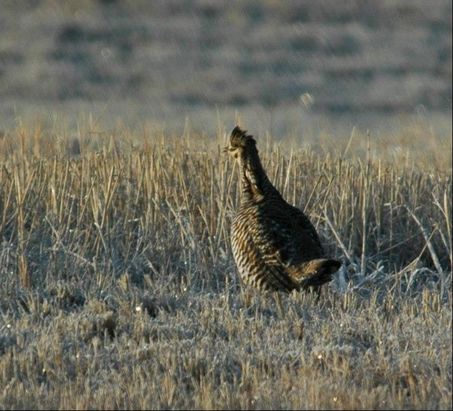Seasonal and Interspecific Landscape Use of Sympatric Greater Prairie-Chickens and
Sharp-tailed Grouse
Project Completed! See our Publications Page
Sharp-tailed Grouse
Project Completed! See our Publications Page
Native grasslands throughout the Great Plains of the central U.S. have undergone varying levels of landscape fragmentation, although the Sandhills region in Nebraska remains largely intact. Cropland development occurs at the margins of the Sandhills, and has provided potential for alternative winter forage sites for culturally and economically important galliforms, including greater prairie-chickens (Tympanuchus cupido) and sharp-tailed grouse (Tympanuchus phasianellus). Working with Drs. Larkin Powell and Walter Schacht of the University of Nebraska-Lincoln, our objectives were to understand intraspecific seasonal (summer, winter) shifts and interspecific differences in landscape use of sympatric Tympanuchus spp in the grass-stabilized Sandhills of northcentral Nebraska.
We captured and radiomarked birds during 2015–2016 and used aerial telemetry to monitor birds. Greater prairie-chickens tended to move longer distances from breeding season to winter locations (up to 65 km), while all sharp-tailed grouse stayed within 15 km of their breeding season range. We will use presence-only location data and ecological and anthropogenic variables (e.g., land-cover types, topography, vegetation productivity, roads) in a maximum entropy (MaxEnt) approach to develop and compare seasonal species distribution models. Our approach includes model validation, and methods to quantify model performance. We will also compare differences in landscape use by categorizing intervals of probability of presence for each species and determining percent overlap. Our results will provide support to coordinated, landscape-level management of galliforms, which can then be extended to seasonal priorities during management decisions by private landowners.
We captured and radiomarked birds during 2015–2016 and used aerial telemetry to monitor birds. Greater prairie-chickens tended to move longer distances from breeding season to winter locations (up to 65 km), while all sharp-tailed grouse stayed within 15 km of their breeding season range. We will use presence-only location data and ecological and anthropogenic variables (e.g., land-cover types, topography, vegetation productivity, roads) in a maximum entropy (MaxEnt) approach to develop and compare seasonal species distribution models. Our approach includes model validation, and methods to quantify model performance. We will also compare differences in landscape use by categorizing intervals of probability of presence for each species and determining percent overlap. Our results will provide support to coordinated, landscape-level management of galliforms, which can then be extended to seasonal priorities during management decisions by private landowners.
Greater Prairie-Chicken Sharp-tailed Grouse
Copyright 2024 Wildlife Ecology Institute
Copyright 2024 Wildlife Ecology Institute


